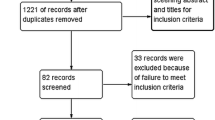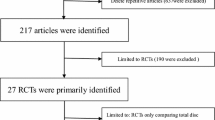Abstract
Purpose
The aim of the study was to evaluate whether there is a superior clinical effect of artificial cervical arthroplasty compared with anterior cervical discectomy and fusion (ACDF) for the treatment of one-level cervical degenerative disc disease (CDDD).
Methods
A comprehensive literature search of multiple databases, including PubMed, ScienceDirect, Scopus, Embase, Cochrane Central Register of Controlled Trials, was conducted to identify studies that met the inclusion criteria. Methodological quality was assessed and relevant data were extracted, and if appropriate, meta-analysis was performed.
Results
Thirteen randomized controlled trials were identified. At 24 months post-operatively, total disc replacement (TDR) was demonstrated to be more beneficial for patients compared with ACDF for the following outcomes: neurological success [odds ratio (OR) 1.92; 95 % confidence interval (CI) 1.47–2.49; p < 0.00001], range of motion [mean differences (MD), 6.67; 95 % CI 4.82–8.53; p < 0.00001], secondary surgical procedures (OR 0.50; 95 % CI 0.37–0.68; p < 0.00001), and visual analogue scale neck pain scores (MD −5.99; 95 % CI −10.54 to −1.45; p = 0.001) and visual analogue scale arm pain scores (MD −3.23; 95 % CI −6.48 to 0.02; p = 0.004). Other outcomes, including length of the hospital stay (MD −0.03; 95 % CI −0.18 to 0.12; p = 0.68), blood loss (MD 6.92 mL; 95 % CI −3.09 to 16.92 mL; p = 0.18), Neck Disability Index scores (MD −1.00; 95 % CI −5.28 to 3.28; p = 0.65) and rate of adverse events [risk ratio (RR), 0.93; 95 % CI 0.76–1.15; p = 0.52] demonstrated no differences between the 2 groups. Although the TDR group had a significantly longer operation time than the ACDF group, it was not considered clinically important.
Conclusions
For patients with one-level CDDD, TDR was found to be more superior than ACDF in terms of neurological success, secondary surgical procedures, visual analogue scale pain scores and range of motion at 24 months post-operatively. Therefore, cervical arthroplasty is a safe and effective surgical procedure for treating one-level CDDD. We suggest adopting TDR on a large scale; with failure of TDR, ACDF would be performed.











Similar content being viewed by others
References
Yang YC, Nie L, Cheng L et al (2009) Clinical and radiographic reports following cervical arthroplasty: a 24-month follow-up. Int Orthop 33(4):1037–1042
Peng-Fei S, Yu-Hua J (2008) Cervical disc prosthesis replacement and interbody fusion: a comparative study. Int Orthop 32(1):103–106
Goffin J, Van Calenbergh F, van Loon J (2003) Intermediate follow-up after treatment of degenerative disc disease with the Bryan cervical disc prosthesis: single-level and bi-level. Spine 28:2673–2678
Mummaneni PV, Haid RW (2004) The future in the care of the cervical spine: interbody fusion and arthroplasty. Invited submission from the joint section meeting on disorders of the spine and peripheral nerves, March 2004. J Neurosurg Spine 1:155–159
Wigfield C, Gill S, Nelson R (2002) Influence of an artificial cervical joint compared with fusion on adjacent-level motion in the treatment of degenerative cervical disc disease. J Neurosurg 96(1 suppl):17–21
Smith HE, Wimberley DW, Vaccaro AR (2004) Cervical arthroplasty: material properties. Neurosurg Focus 17:E3
Chen J, Wang X, Bai W (2012) Prevalence of heterotopic ossification after cervical total disc arthroplasty: a meta-analysis. Eur Spine J 21:674–680
Leung C, Casey AT, Goffin J (2005) Clinical significance of heterotopic ossification in cervical disc replacement: a prospective multicenter clinical trial. Neurosurgery 57:759–763; discussion 759–763
Pickett GE, Sekhon LH, Sears WR (2006) Complications with cervical arthroplasty. J Neurosurg Spine 4:98–105
Gao Y, Liu M, Li T (2013) A meta-analysis comparing the results of cervical disc arthroplasty with anterior cervical discectomy and fusion (ACDF) for the treatment of symptomatic cervical disc disease. J Bone Joint Surg Am 95(6):555–561
Higgins JP, Altman DG, Gotzsche PC et al (2011) The Cochrane Collaboration’s tool for assessing risk of bias in randomised trials. BMJ 343:d5928
Porchet F, Metcalf NH (2004) Clinical outcomes with the Prestige II cervical disc: preliminary results from a prospective randomized clinical trial. Neurosurg Focus 17:E6
Mummaneni PV, Burkus JK, Haid RW et al (2007) Clinical and radiographic analysis of cervical disc arthroplasty compared with allograft fusion: a randomized controlled clinical trial. J Neurosurg Spine 6(3):198–209
Nabhan A, Steudel WI, Nabhan A et al (2007) Segmental kinematics and adjacent level degeneration following disc replacement versus fusion: RCT with three years of follow-up. J Long Term Eff Med Implants 17(3):229–236
Riina J, Patel A, Dietz JW et al (2008) Comparison of single-level cervical fusion and a metal-on-metal cervical disc replacement device. Am J Orthop 37(4):E71–E77
Heller J, Sasso RC, Papadopoulos SM et al (2009) Comparison of BRYAN cervical disc arthroplasty with anterior cervical decompression and fusion: clinical and radiographic results of a randomized, controlled, clinical trial. Spine 34(2):101–107
Garrido BJ, Taha TA, Sasso RC (2010) Clinical outcomes of Bryan cervical disc arthroplasty a prospective, randomized, controlled, single site trial with 48-month follow-up. J Spinal Disord Tech 23(6):367–371
Burkus JK, Haid RW, Traynelis VC et al (2010) Long-term clinical and radiographic outcomes of cervical disc replacement with the Prestige disc: results from a prospective randomized controlled clinical trial. J Neurosurg Spine 13(3):308–318
Sasso RC, Anderson PA, Riew KD et al (2011) Results of cervical arthroplasty compared with anterior discectomy and fusion: four-year clinical outcomes in a prospective, randomized controlled trial. J Bone Joint Surg Am 93:1684–1692
Coric D, Nunley PD, Guyer RD et al (2011) Prospective, randomized, multicenter study of cervical arthroplasty: 269 patients from the Kineflex|C artificial disc investigational device exemption study with a minimum 2-year follow-up: clinical article. J Neurosurg Spine 15:348–358
Zhang X, Zhang X, Chen C et al (2012) Randomized, controlled, multicenter, clinical trial comparing BRYAN cervical disc arthroplasty with anterior cervical decompression and fusion in China. Spine 37(6):433–438
Phillips FM, Lee JY, Geisler FH et al (2013) A prospective, randomized, controlled clinical investigation comparing PCM cervical disc arthroplasty with anterior cervical discectomy and fusion. 2-year results from the US FDA IDE clinical trial. Spine 38(15):E907–E918
Coric D, Kim PK, Clemente JD et al (2013) Prospective randomized study of cervical arthroplasty and anterior cervical discectomy and fusion with long-term follow-up: results in 74 patients from a single site. J Neurosurg Spine 18:36–42
Zigler JE, Delamarter R, Murrey D et al (2013) ProDisc-C and anterior cervical discectomy and fusion as surgical treatment for single-level cervical symptomatic degenerative disc disease: five-year results of a food and drug administration study. Spine 38(3):203–209
Riew KD, Buchowski JM, Sasso R et al (2008) Cervical disc arthroplasty compared with arthrodesis for the treatment of myelopathy. J Bone Joint Surg Am 90(11):2354–2364
Eck JC, Humphreys SC, Lim TH et al (2002) Biomechanical study on the effect of cervical spine fusion on adjacent-level intradiscal pressure and segmental motion. Spine 27(22):2431–2434
Dmitriev AE, Cunningham BW, Hu N et al (2005) Adjacent level intradiscal pressure and segmental kinematics following a cervical total disc arthroplasty: an in vitro human cadaveric model. Spine 30:1165–1172
Duggal N, Pickett GE, Mitsis DK et al (2004) Early clinical and biomechanical results following cervical arthroplasty. Neurosurg Focus 17:E9
Murrey D, Janssen M, Delamarter R et al (2009) Results of the prospective, randomized, controlled multicenter Food and Drug Administration investigational device exemption study of the ProDisc-C total disc replacement versus anterior discectomy and fusion for the treatment of 1-level symptomatic cervical disc disease. Spine J 9(4):275–286
Park DK, Lin EL, Phillips FM (2011) Index and adjacent level kinematics after cervical disc replacement and anterior fusion: in vivo quantitative radiographic analysis. Spine 36:721–730
Moatz B, Tortolani PJ (2012) Cervical disc arthroplasty: pros and cons. Surg Neurol Int 3(suppl 3):216–224
Chang UK, Kim DH, Lee MC et al (2007) Changes in adjacent-level disc pressure and facet joint force after cervical arthroplasty compared with cervical discectomy and fusion. J Neurosurg Spine 7:33–39
Chen J, Wang X, Bai W et al (2012) Prevalence of heterotopic ossification after cervical total disc arthroplasty: a meta-analysis. Eur Spine J 21:674–680
Mummaneni PV, Haid RW (2004) The future in the care of the cervical spine: interbody fusion and arthroplasty. Invited submission from the joint section meeting on disorders of the spine and peripheral nerves, March 2004. J Neurosurg Spine 1:155–159
Pickett GE, Mitsis DK, Sekhon LH et al (2004) Effects of a cervical disc prosthesis on segmental and cervical spine alignment. Neurosurg Focus 17:E5
Stulik J, Pitzen TR, Chrobok J et al (2007) Fusion and failure following anterior cervical plating with dynamic or rigid plates: 6-months results of a multi-centric, prospective, randomized, controlled study. Eur Spine J 16:1689–1694
Pitzen TR, Chrobok J, Stulik J et al (2009) Implant complications, fusion, loss of lordosis, and outcome after anterior cervical plating with dynamic or rigid plates: two-year results of a multi-centric, randomized, controlled study. Spine 34(7):641–646
Carrier CS, Bono CM, Lebl DR (2013) Evidence-based analysis of adjacent segment degeneration and disease after ACDF: a systematic review. Spine J 13(10):1370
Acknowledgments
The present study was financially supported by National Programme on Key Basic Research Project (973 Programme; Grant No. 2012CB619105).
Conflict of interest
The authors declare that they have no conflicts of interest concerning this article.
Author information
Authors and Affiliations
Corresponding author
Rights and permissions
About this article
Cite this article
Luo, J., Huang, S., Gong, M. et al. Comparison of artificial cervical arthroplasty versus anterior cervical discectomy and fusion for one-level cervical degenerative disc disease: a meta-analysis of randomized controlled trials. Eur J Orthop Surg Traumatol 25 (Suppl 1), 115–125 (2015). https://doi.org/10.1007/s00590-014-1510-4
Received:
Accepted:
Published:
Issue Date:
DOI: https://doi.org/10.1007/s00590-014-1510-4




